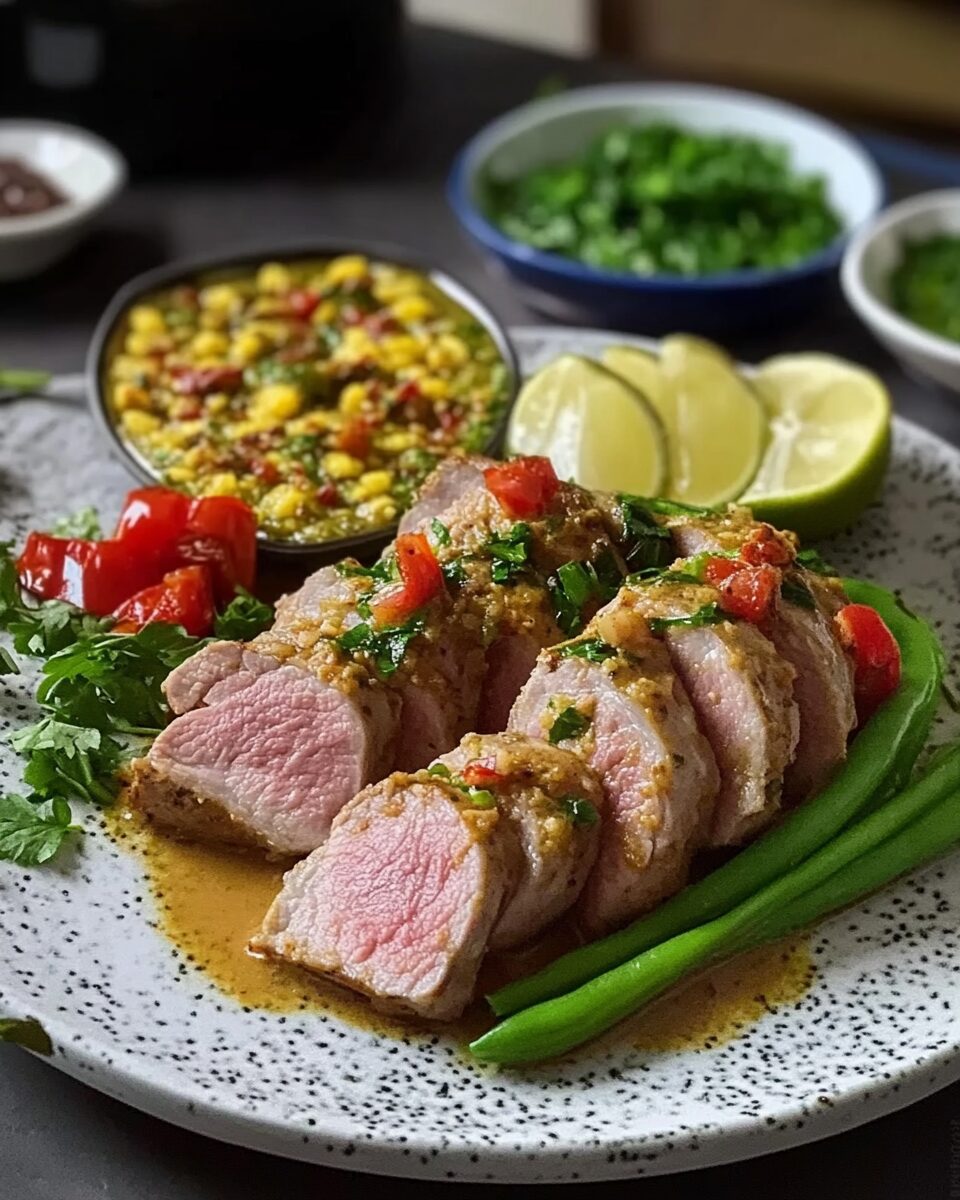This flavorful dinner entrée features a succulent pork tenderloin seasoned to perfection and complemented by a spicy, creamy mustard sauce. Ideal for special occasions or a delightful weeknight meal, this dish combines the richness of heavy cream with the sharpness of horseradish and Dijon mustard, all balanced with a hint of cayenne pepper.
Full Recipe:
Ingredients
- 1 (1-pound) whole pork tenderloin
- Salt and freshly ground black pepper to taste
- 2 teaspoons vegetable oil
- ½ cup chicken broth
- 2 tablespoons heavy cream
- 1 tablespoon extra-hot prepared horseradish
- 1 tablespoon Dijon mustard
- ¼ teaspoon cayenne pepper
- 1 tablespoon cold unsalted butter
- 1 teaspoon chopped fresh chives
Directions
-
Preheat Oven: Set the oven to 375°F (190°C). Season the pork tenderloin with salt and freshly ground black pepper.
-
Sear Pork: In an ovenproof skillet, heat vegetable oil over high heat. Add the pork and cook until browned on one side, approximately 3 to 4 minutes.
-
Roast Pork: Flip the pork, then transfer the skillet to the preheated oven. Roast until the pork is browned and slightly pink in the center, about 20 to 25 minutes. An instant-read thermometer should register at least 145°F (63°C) when inserted into the center. Transfer the pork to a plate and set aside.
-
Prepare Sauce: Remove any excess oil from the skillet and place it over medium-high heat. Pour in the chicken broth and bring to a boil, scraping up any browned bits from the bottom of the skillet. Whisk in heavy cream, horseradish, Dijon mustard, and cayenne pepper. Continue cooking until the sauce thickens, approximately 3 to 4 minutes.
-
Finish Sauce: Remove the skillet from heat and whisk in the cold butter until the sauce is smooth. Stir in chopped fresh chives.
-
Serve: Slice the pork into ½-inch thick pieces and serve topped with the prepared sauce.
Nutritional Information
Per serving:
- Calories: 350
- Protein: 30g
- Carbohydrates: 2g
- Fat: 24g
- Saturated Fat: 12g
- Cholesterol: 120mg
- Sodium: 400mg
- Fiber: 0g
- Sugar: 1g
Historical Background of Pork Tenderloin Diablo
The “Diablo” style of cooking, characterized by the use of spicy sauces, has its roots in French cuisine. Dishes labeled “à la Diable” traditionally feature a piquant sauce made with mustard, vinegar, and spices, designed to add a devilish heat to the meal. Over time, this culinary technique crossed borders and was adapted in various cuisines, including American cooking. The fusion of tender pork with a spicy Diablo sauce exemplifies this cross-cultural adaptation, resulting in a dish that is both rich in history and flavor.
The Role of Mustard and Horseradish in Culinary Traditions
Mustard and horseradish are integral to many culinary traditions, valued for their sharp, pungent flavors that enhance a variety of dishes.
-
Mustard: Originating from the seeds of the mustard plant, this condiment has been used since ancient times. In the context of Pork Tenderloin Diablo, Dijon mustard is preferred for its smooth texture and robust flavor, which melds seamlessly into the sauce, providing both heat and depth.
-
Horseradish: A root vegetable known for its intense, spicy flavor, horseradish has been utilized in European cuisines for centuries. When incorporated into the Diablo sauce, it adds a sharp, tangy element that complements the richness of the pork and the creaminess of the sauce.
Preparation Techniques
Achieving the perfect Pork Tenderloin Diablo involves attention to detail in both the preparation of the meat and the sauce.
-
Searing the Pork: Begin by seasoning the pork tenderloin with salt and freshly ground black pepper. Searing the meat in a hot, ovenproof skillet with vegetable oil until browned on one side develops a flavorful crust. This process not only enhances the taste but also locks in the juices, ensuring a moist and tender result.
-
Oven Roasting: After searing, flip the tenderloin and transfer the skillet to a preheated oven. Roasting at 375°F (190°C) until the internal temperature reaches at least 145°F (63°C) ensures the pork is cooked through yet remains juicy. Once done, transfer the pork to a plate and allow it to rest, which helps in redistributing the juices within the meat.
-
Crafting the Diablo Sauce: In the same skillet, discard any excess oil and place it over medium-high heat. Deglaze the pan with chicken broth, scraping up the browned bits that contribute to the sauce’s depth of flavor. Incorporate heavy cream, extra-hot prepared horseradish, Dijon mustard, and cayenne pepper, whisking until the mixture reduces to a thick, luscious sauce. Off the heat, whisk in cold unsalted butter to add a silky finish, and stir in freshly chopped chives for a subtle oniony note.
-
Serving: Slice the rested pork into 1/2-inch medallions and arrange them on a serving platter. Generously spoon the Diablo sauce over the slices, ensuring each piece is well-coated to deliver a burst of flavor in every bite.
Variations and Customizations
Pork Tenderloin Diablo is a versatile dish that lends itself to various adaptations to suit different palates and dietary preferences.
-
Heat Adjustment: The spiciness of the Diablo sauce can be tailored by modifying the amount of cayenne pepper and horseradish. For a milder version, reduce these ingredients; for an extra kick, consider adding a dash of hot sauce or incorporating finely chopped fresh chili peppers.
-
Herb Enhancements: Introducing herbs such as rosemary, thyme, or parsley can add aromatic complexity to the dish. These can be incorporated into the sauce or used as a garnish to elevate the presentation and flavor profile.
-
Alternative Proteins: While pork tenderloin is traditional, this Diablo sauce pairs well with other proteins. Chicken breasts, beef tenderloin, or even firm tofu can serve as substitutes, accommodating various dietary preferences and adding variety to your menu.
-
Cream Substitutes: For a lighter version of the sauce, substitute heavy cream with half-and-half or a non-dairy alternative like coconut milk. This adjustment reduces the richness while maintaining a creamy texture, catering to those with dietary restrictions or preferences.
Serving Suggestions
To create a well-rounded meal, consider pairing Pork Tenderloin Diablo with complementary side dishes that balance the richness and spiciness of the main course.
-
Starch Accompaniments: Creamy mashed potatoes, fluffy rice pilaf, or crusty French bread are excellent choices. These sides help absorb the flavorful sauce and provide a neutral base that balances the dish’s spiciness.
-
Vegetable Sides: Roasted or steamed vegetables such as asparagus, green beans, or Brussels sprouts add color and nutritional value to the plate. Their natural sweetness and slight bitterness offer a pleasant contrast to the rich, spicy pork.
-
Salads: A crisp green salad with a light vinaigrette can refresh the palate and cut through the richness of the Diablo sauce. Consider incorporating ingredients like arugula, cherry tomatoes, and thinly sliced red onions for a vibrant and flavorful salad.
-
Beverage Pairings: A chilled white wine like Sauvignon Blanc or a light red such as Pinot Noir complements the dish’s flavors. For beer enthusiasts, a crisp lager or a hoppy IPA can balance the spiciness and richness of the sauce.
Why Pork Tenderloin Diablo Stands Out
Pork Tenderloin Diablo is not just another pork dish—it stands out due to its unique combination of creamy, spicy, and tangy flavors. The contrast between the rich Dijon mustard, the bold heat of horseradish, and the smoothness of the cream creates a flavor profile that is both sophisticated and comforting. Additionally, this dish is incredibly versatile. It can be served as an elegant dinner for guests, a cozy family meal, or even repurposed into sandwiches and wraps the next day. The balance of heat and creaminess makes it appealing to a wide range of palates, and its simplicity ensures that even novice cooks can execute it successfully.
Conclusion
Pork Tenderloin Diablo is a dish that perfectly balances bold flavors, tender meat, and a luscious sauce, making it a standout meal for any occasion. With its deep-rooted influences from French cuisine and its modern adaptations, it continues to be a favorite among those who enjoy a little heat with their meals.






